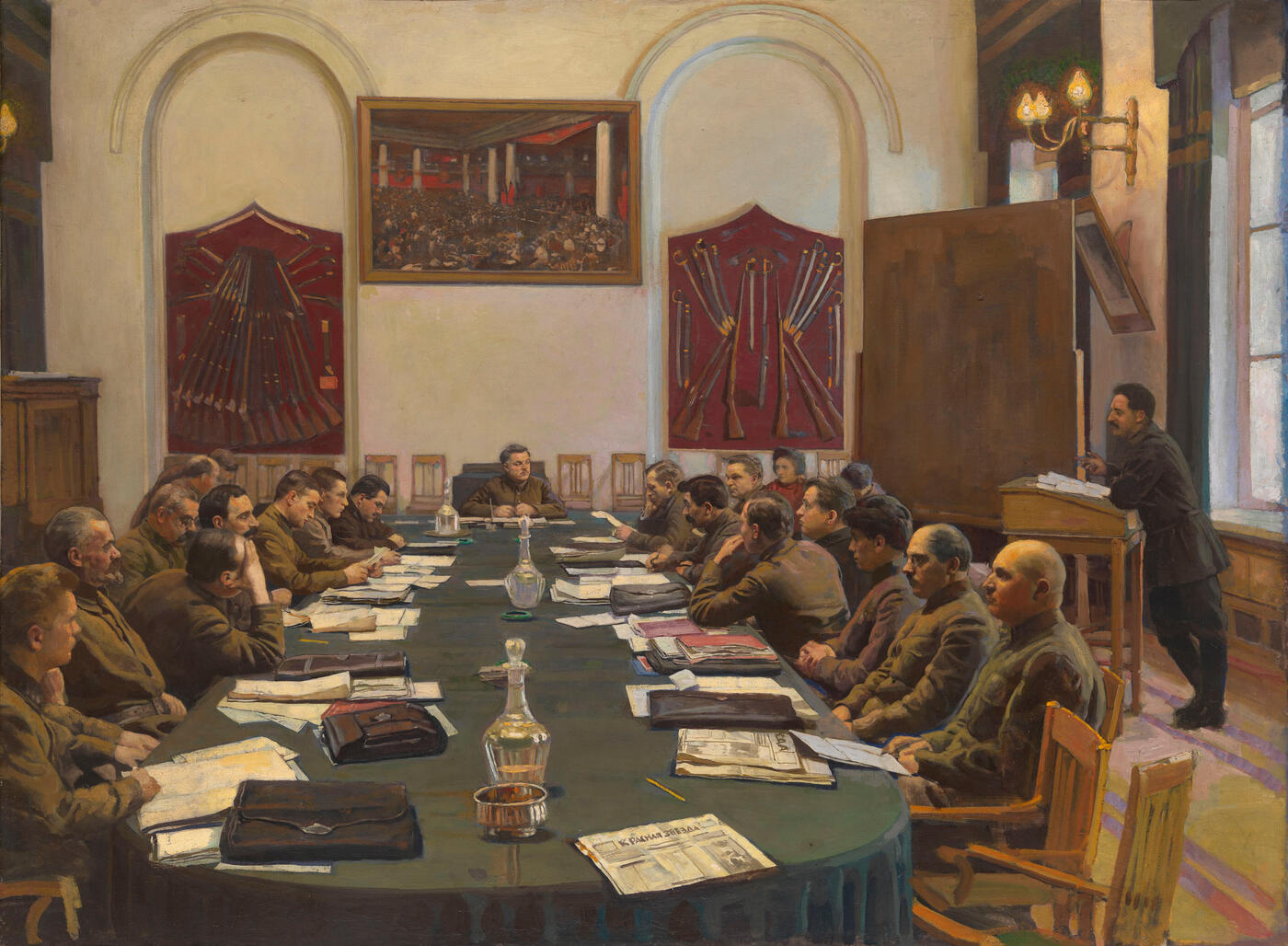5 June 2013 Russian Art Auctions
5 June 2013

103. BRODSKY, ISAAK (1884-1939)
Assembly of the Revolutionary Military Council of the USSR, Chaired by Kliment Voroshilov, signed on the reverse.
Oil on canvas, 95.5 by 129.5 cm.
200,000–300,000 GBP
Executed c. 1928.
Related Literature: For another version of the present lot, see I.I. Brodsky, Sbornik statei, Leningrad, Izdanie yubileinogo komiteta, 1929.
Isaak Brodsky’s painting Assembly of the Revolutionary Military Council of the USSR, Chaired by Kliment Voroshilov is a unique document of its time.
The commission was an initiative of Voroshilov to mark the 10th anniversary of the Red Army and, according to the artist himself, “I was invited to a session of the Revolutionary Military Council [Revvoensoviet] to help me collect material for the picture, and I did a series of sketches there (…) Shortly before I had consulted with Comrade Voroshilov as to whom I should depict as the speaker, whom I saw as the central figure of the composition. Without a moment’s hesitation, Kliment Yefremovich proposed Comrade Ordzhonikidze. He considered this of great importance as it would in itself underline Comrade Ordzhonikidze’s vital role in the defence of our country…”
Directives from Voroshilov himself explain much of this painting’s history. On his advice Brodsky portrayed Sergo Ordzhonikidze at the lectern – who by 1928 was no longer a member of the Revvoensoviet. At the personal request of the People’s Commissar, the artist produced several portrait studies and only after one was approved did he begin painting Voroshilov in the Chairman’s place. Furthermore, when the picture was completed and the artist presented it for his client’s inspection, it turned out that the People’s Commissar too had his own, conflicting view on the composition of the painting. “His thoughts on the composition of this piece were so significant,” wrote Brodsky in his memoirs, “that I agreed to make major changes to the finished painting”.
Thus a second version came into being, which was approved from on high and authorised for publication, now in the Central Armed Forces Museum. But the painting offered here for auction is the artist’s original, more intimate, composition. The members of this small gathering sit in their places listening quietly and decorously to the speaker. Two chairs in the foreground are empty, allowing the artist to capture the entire space in one viewing. Stalin is taking notes, Tukhachevsky is reading, Bazilevich stares straight ahead, motionless. The second reworking of the canvas, however, is filled with a theatrical dynamism. There are insufficient chairs for the full turnout of council members, and some are obliged to stand behind during the meeting. The only directly repeated elements are the authorised image of Voroshilov and the listener leaning on his elbow, as well as the faithfully rendered meeting room itself. White walls, the two red boards displaying weapons, a green baize tablecloth,
brown-black curtains, a blackboard by the lectern and, in the very centre, another painting by Brodsky. This one, The Ceremonial Opening of the Second Congress of the Comintern, was completed in 1924 and did indeed grace the Revvoensoviet meeting room, both in its former home in the Alexandrovsky Military School on Znamenka Street and then in Frunze Street.
Today this picture, which survived the period when works portraying “enemies of the people” were destoyed, has become a memorial to its time. This is the very task with which the artist was charged: to create a monumental collective portrait and to record for posterity, in a historical, documentary painting, a meeting of the leaders of the “first workers’ and peasants’ army in the world”. And Brodsky fulfilled that task with all the skill and mastery that resided in him.
Notes on symbols:
* Indicates 5% Import Duty Charge applies.
Ω Indicates 20% Import Duty Charge applies.
§ Indicates Artist's Resale Right applies.
† Indicates Standard VAT scheme applies, and the rate of 20% VAT will be charged on both hammer price and premium.